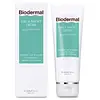What's inside
What's inside
 Benefits
Benefits

 Concerns
Concerns

 Ingredients Side-by-side
Ingredients Side-by-side

Water
Skin ConditioningTriethylhexanoin
MaskingIsohexadecane
EmollientIsodecyl Neopentanoate
EmollientGlycerin
HumectantPEG-30 Dipolyhydroxystearate
EmulsifyingC18-36 Acid Glycol Ester
EmollientAllantoin
Skin ConditioningPanthenol
Skin ConditioningMagnesium Stearate
Cosmetic ColorantMagnesium Sulfate
Sorbitan Isostearate
EmulsifyingPolyglyceryl-3 Ricinoleate
EmulsifyingPhenoxyethanol
PreservativeDiazolidinyl Urea
PreservativeMethylparaben
PreservativeParfum
MaskingEthylparaben
PreservativeButylparaben
MaskingPropylparaben
PreservativeCitronellol
PerfumingLinalool
PerfumingCinnamyl Alcohol
PerfumingGeraniol
PerfumingBenzyl Salicylate
PerfumingCitric Acid
BufferingEugenol
PerfumingAlpha-Isomethyl Ionone
PerfumingWater, Triethylhexanoin, Isohexadecane, Isodecyl Neopentanoate, Glycerin, PEG-30 Dipolyhydroxystearate, C18-36 Acid Glycol Ester, Allantoin, Panthenol, Magnesium Stearate, Magnesium Sulfate, Sorbitan Isostearate, Polyglyceryl-3 Ricinoleate, Phenoxyethanol, Diazolidinyl Urea, Methylparaben, Parfum, Ethylparaben, Butylparaben, Propylparaben, Citronellol, Linalool, Cinnamyl Alcohol, Geraniol, Benzyl Salicylate, Citric Acid, Eugenol, Alpha-Isomethyl Ionone
Ingredients Explained
These ingredients are found in both products.
Ingredients higher up in an ingredient list are typically present in a larger amount.
Allantoin is a soothing ingredient known for its protective and moisturizingg properties. Because of this, it is often added to products with strong active ingredients.
Studies show higher concentrations of this ingredient can promote wound healing.
Though it can be derived from the comfrey plant, allantoin is produced synthetically for cosmetic products to ensure purity.
Learn more about AllantoinButylparaben is a preservative, is a paraben, and is not reef safe. It can be bad for dry skin and worsen eczema.
Ethylparaben is a preservative, is a paraben, and is not reef safe.
Glycerin is already naturally found in your skin. It helps moisturize and protect your skin.
A study from 2016 found glycerin to be more effective as a humectant than AHAs and hyaluronic acid.
As a humectant, it helps the skin stay hydrated by pulling moisture to your skin. The low molecular weight of glycerin allows it to pull moisture into the deeper layers of your skin.
Hydrated skin improves your skin barrier; Your skin barrier helps protect against irritants and bacteria.
Glycerin has also been found to have antimicrobial and antiviral properties. Due to these properties, glycerin is often used in wound and burn treatments.
In cosmetics, glycerin is usually derived from plants such as soybean or palm. However, it can also be sourced from animals, such as tallow or animal fat.
This ingredient is organic, colorless, odorless, and non-toxic.
Glycerin is the name for this ingredient in American English. British English uses Glycerol/Glycerine.
Learn more about GlycerinMethylparaben is a preservative and is a paraben. It is used to prevent the growth of fungus, mold, and other harmful bacteria. Parabens are chemicals used as preservatives in both cosmetics and food.
Methylparaben can be synthetically created. It can also be found naturally in some fruits, such as blueberries.
Oftentimes, Methylparaben is combined with other parabens to help increase the shelf life.
The safety of Methylparaben is currently being studied. While ongoing studies are looking into the safety of parabens, the results have been very mixed. Some studies have not found Methylparaben to be harmful.
Learn more about MethylparabenPhenoxyethanol is a preservative that has germicide, antimicrobial, and aromatic properties. Studies show that phenoxyethanol can prevent microbial growth. By itself, it has a scent that is similar to that of a rose.
It's often used in formulations along with Caprylyl Glycol to preserve the shelf life of products.
Propylparaben is a preservative and is a paraben with antifungal and antimicrobial properties.
This ingredient can be naturally found in plants and insects, but most of it is synthetically manufactured for human use. In cosmetics, it is usually created by reacting para-aminobenzoic acid and propanol (an alcohol).
You can usually find this ingredient in water-based products.
Parabens have come under controversy due to the claim they are hormone disruptors. Studies show conflicting results. We recommend speaking with a professional if you have any concerns.
Propylparaben is commonly found in food, medicine, and cosmetics.
Learn more about PropylparabenWater. It's the most common cosmetic ingredient of all. You'll usually see it at the top of ingredient lists, meaning that it makes up the largest part of the product.
So why is it so popular? Water most often acts as a solvent - this means that it helps dissolve other ingredients into the formulation.
You'll also recognize water as that liquid we all need to stay alive. If you see this, drink a glass of water. Stay hydrated!
Learn more about Water